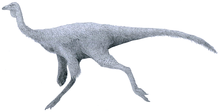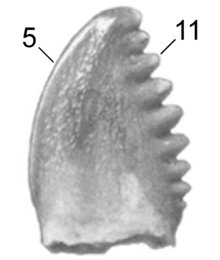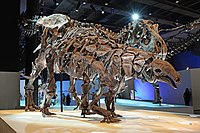Lance Formation
| Lance Formation | |
|---|---|
Ma | |
Sedimentary | |
| Underlies | Fort Union Formation |
| Overlies | Meeteetse Formation |
| Thickness | up to 600 metres (1,970 ft) |
| Lithology | |
| Primary | Sandstone, siltstone, shale |
| Location | |
| Region | |
| Country | |
| Type section | |
| Named for | Lance Creek, Wyoming |

The Lance (Creek) Formation is a division of
The Lance Formation occurs above the Baculites clinolobatus ammonite marine zone in Wyoming, the top of which has been dated to about 69 million years ago, and extends to the K-Pg boundary, 66 million years ago. However, the characteristic land vertebrate fauna of the Lancian age (which take its name from this formation) is only found in the upper strata of the Lance, roughly corresponding to the thinner equivalent formations such as the Hell Creek Formation, the base of which has been estimated at 66.8 million years old.[1]
Description
The formation is described by W.G. Pierce as thick-bedded, buff-colored sandstone, and drab to green shale. It is Upper Cretaceous in age.[2]
The formation varies in thickness from about 90 m (300 ft.) in North Dakota, to almost 600 m (2,000 ft.) in parts of Wyoming.
Depositional environment
The Lance Formation was laid down by streams, on a coastal plain along the edge of the
Paleontology
At least tens of thousands of Late Cretaceous vertebrate remains have been recovered from the Lance Formation. Fossils ranging from microscopic elements to extensive
Coelurosaurs
Color key
|
Notes Uncertain or tentative taxa are in small text; |
Birds
| Birds reported from the Lance Formation | ||||||
|---|---|---|---|---|---|---|
| Genus | Species | Location | Stratigraphic Position | Material | Notes | Images |
|
A. retusus |
Reclassified as Palintropus retusus |
|||||
|
C. major |
A possible charadriiform bird | |||||
|
C. petra |
Reclassified as Lamarqueavis minima[7] | |||||
|
C. rara |
|
A charadriiform | ||||
|
C. retusa |
Reclassified as Palintropus retusus | |||||
|
C. minima |
Reclassified as Lamarqueavis minima[7] | |||||
|
"Cimolopteryx" |
"C." maxima |
|
A charadriiform bird, not necessarily closely related to Cimolopteryx.[6]
| |||
|
G. augustus |
|
A possible charadriiform[8] | ||||
|
L. minima |
|
A charadriiform.[7] | ||||
|
L. petra |
|
A charadriiform.[7] | ||||
|
L. estesi |
|
A possible procellariiform[8] | ||||
|
"Lonchodytes" |
"L." pterygius |
|
A possible charadriiform.[8] | |||
|
"P." vetus |
A bird similar to | |||||
|
P. retusus |
|
A basal ornithuromorph belonging to Ambiortiformes.[9]
| ||||
|
P. skutchi |
A hesperornithiform possibly also present in the Hell Creek Formation.[10]
| |||||
|
T. clemensi |
|
A possible presbyornithid.[12] | ||||
|
Unnamed presbyornithid |
Indeterminate |
A presbyornithid[8] | ||||
|
Unnamed enantiornithean |
Unnamed |
|
An enantiornithean, previously referred to "Ornithomimus" minutus[13]
| |||
|
Unnamed avian
|
Indeterminate |
|
An indeterminate avian[8]
| |||
|
Unnamed phalacrocoracid |
Indeterminate |
|
A possible phalacrocoracid.[8]
| |||
|
"Unnamed ornithurine A"[6] |
Indeterminate |
Originally thought to belong to Cimolopteryx rara, but probably a new species. Also present in the Frenchman Formation.[6] | ||||
|
"Unnamed ornithurine C"[6] |
Indeterminate |
|
Also present in the Hell Creek Formation.[6] | |||
|
"Unnamed ornithurine E"[6] |
Indeterminate |
Also present in the Hell Creek Formation.[6] | ||||
|
"Unnamed ornithurine F"[6] |
Indeterminate |
Originally thought to belong to "Cimolopteryx" maxima, but probably a new species.[6] | ||||
Other coelurosaurs
| Miscellaneous coelurosaurs of the Lance Formation
| ||||||
|---|---|---|---|---|---|---|
| Genus | Species | Location | Stratigraphic Position | Material | Notes | Images |
|
A. amplus |
Teeth, type specimen
|
Tyrannosaurus rex
|
   | |||
|
A. cristatus |
Teeth, type specimen
| |||||
|
"O." sedens |
"Sacrum and fragmentary illium" |
An ornithomimid. | ||||
|
P. caperatus |
Teeth, type specimen
|
A troodontid | ||||
|
P. bakkeri |
Teeth, type specimen
|
A troodontid
| ||||
|
T. rex |
Several partial specimens and teeth |
A tyrannosaurid originally identified from the McRae, North Horn, Scollard, and Willow Creek Formations. Synonyms with type specimens from this formation include Dynamosaurus imperiosus and Manospondylus gigas.[15]
| ||||
| Nanotyrannus | N. lancensis | Synonym of Tyrannosaurus. | ||||
Ornithischia
Ankylosaurs
Ankylosaurs of the Lance Formation
| ||||||
|---|---|---|---|---|---|---|
| Genus | Species | Location | Stratigraphic Position | Material | Notes | Images |
|
A. magniventris [16] |
|
More than 70 osteoderms and a tooth |
An ankylosaurid, originally identified from the Hell Creek Formation .
|
   | ||
|
D. schlessmani[17] |
|
A nearly complete skull, several teeth and osteoderms. |
A nodosaurid
| |||
|
E. sp.[18] |
|
Teeth |
A nodosaurid. Fossils have been unearthed in the Hell Creek Formation, the Ferris Formation, the Dinosaur Park Formation, the Horseshoe Canyon Formation, and the Denver Formation.[19][20][21][22][23]
| |||
|
"P. latus"[18] |
|
Teeth |
Probably a Pachycephalosauridae.[24]
| |||
Marginocephalians
Marginocephalians reported from the Lance Formation
| ||||||
|---|---|---|---|---|---|---|
| Genus | Species | Location | Stratigraphic Position | Material | Notes | Images |
|
A. sylvestris |
"Partial sacrum and pelvis," |
A dubious ceratopsid probably synonymous with Triceratops horridus |
Leptoceratops gracilis Nedoceratops hatcheri Pachycephalosaurus wyomingensis Stygimoloch spinifer Torosaurus latus Triceratops horridus | |||
|
L. gracilis |
A ceratopsian | |||||
|
N. hatcheri |
"[One] skull," |
A ceratopsid possibly synonymous with Triceratops horridus.[26] Synonyms include Diceratops hatcheri and Diceratus hatcheri. | ||||
|
P. wyomingensis |
Fragmentary specimens including the type specimen .
|
A pachycephalosaur . Synonyms with type specimens from this formation include Troodon wyomingensis.
| ||||
|
"Palaeoscincus" |
"P." latus |
"Tooth."[24] |
A dubious pachycephalosaur, previously classified as the ankylosaur Palaeoscincus | |||
|
|
S. spinifer |
A pachycephalosaur possibly synonymous with Pachycephalosaurus wyomingensis[27] | ||||
|
T. latus |
Several specimens including the type specimen .
|
A ceratopsid possibly synonymous with Triceratops horridus.[26] Torosaurus gladius, with type specimen from this formation, is a synonym. Also present in the Frenchman and Hell Creek Formations .
| ||||
|
T. horridus T. Indet. |
"Partial skull and skeleton," |
A ceratopsid, also found in the Evanston, Frenchman, Hell Creek, Laramie, and Scollard Formations. Synonyms with type specimens from this formation include T. ingens and T. sulcatus.[25] | ||||
Ornithopods
Indeterminate lambeosaurinae fossils have been found in the Lance Formation.[28]
Ornithopods of the Lance Formation
| ||||||
|---|---|---|---|---|---|---|
| Genus | Species | Location | Stratigraphic Position | Abundance | Notes | Images |
|
E. annectens |
Skull, skeletons, including the type specimen, "mummy", and a bone bed.[29]
|
A hadrosaurid. Synonyms from this formation include Anatosaurus annectens and Claosaurus annectens. Also found in the Frenchman, Hell Creek, Laramie and Scollard Formations. |
 Thescelosaurus neglectus | |||
|
T. neglectus |
Well-preserved skeleton, type specimen
|
A . | ||||
|
T. occidentalis |
Teeth, vertebrae, toe bone (including type specimen )
|
A dubious hadrosaurid possibly synonymous with E. annectens | ||||
|
"T." longiceps |
One partial jaw (YPM 616), type specimen
|
A dubious hadrosaurid possibly synonymous with E. annectens | ||||
Other vertebrates
Other land vertebrates include pterosaurs (e.g. cf. Azhdarcho), crocodiles, champsosaurs, lizards, snakes, turtles, frogs and salamanders.
Remains of
See also
- List of fossil sites (with link directory)
- List of dinosaur-bearing rock formations
References
- ^ Lehman, T. M., Mcdowell, F. W., & Connelly, J. N. (2006). First isotopic (U-Pb) age for the Late Cretaceous Alamosaurus vertebrate fauna of West Texas, and its significance as a link between two faunal provinces. Journal of Vertebrate Paleontology, 26(4), 922–928.
- ^ Pierce, W.G., 1997, Geologic map of the Cody 1 degree x 2 degrees quadrangle, northwestern Wyoming: U.S. Geological Survey, Miscellaneous Geologic Investigations Map I-2500, scale 1:250000.
- ^ Silver, Mark (August 2, 2014) "The Dinosaur Surveyors" The American Surveyor Frederick Maryland
- ^ Stidham, 1998
- ^ Dyke, GJ; Mayr, G. (1999). "Did parrots exist in the Cretaceous period?". Nature 399 (6734): 317–318. doi:10.1038/20583.
- ^ .
- ^ a b c d e f Federico L. Agnolin (2010). "An avian coracoid from the Upper Cretaceous of Patagonia, Argentina". Stvdia Geologica Salmanticensia. 46 (2): 99–119.
- ^ a b c d e f g h i j k l m n o p q r Hope, 2002
- ^ a b Longrich, N. 2009. An ornithurine-dominated avifauna from the Belly River Group (Campanian, Upper Cretaceous) of Alberta, Canada. Cretaceous Research, 30(1): 161–177.
- ^ a b c Elzanowski, Paul and Stidham, 2001. An avian quadrate from the Late Cretaceous Lance Formation of Wyoming. Journal of Vertebrate Paleontology, 20(4): 712–719.
- ^ "Table 11.1," in Weishampel, et al. (2004). Page 215.
- ^ a b Olson, S.L. and Feduccia, A. 1980. Presbyornis and the origin of the Anseriformes (Aves: Charadriomorphae). Smithsonian Contributions to Paleobiology no. 323.
- ^ a b Chiappe, L. M., and Walker, C. A. (2002) Skeletal morphology and systematics of the Cretaceous Euenantiornithes (Ornithothoraces: Enantiornithes): In: Mesozoic Birds, above the heads of Dinosaurs, University of California Press, 240–267.
- ^ "Table 6.1," in Weishampel, et al. (2004). Page 139.
- S2CID 128608668. Retrieved 16 November 2020.
- ^ The Dinosauria 2nd Edition (David B. Weishampel, Halszka Osmólska and Peter Dodson), p. 584, Dinosaur Distribution (DAVID B. WEISHAMPEL, PAUL M. BARRETT, RODOLFO A. CORIA, JEAN LE LOEUFF, XU XING, ZHAO XIJIN, ASHOK SAHNI, ELIZABETH M. P. GOMANI, CHRISTOPHER R. NOTO)
- ^ Bakker, R.T. (1988). Review of the Late Cretaceous nodosauroid Dinosauria: Denversaurus schlessmani, a new armor-plated dinosaur from the Latest Cretaceous of South Dakota, the last survivor of the nodosaurians, with comments on Stegosaur-Nodosaur relationships. Hunteria 1(3):1–23.(1988).
- ^ a b The Dinosauria 2nd Edition (David B. Weishampel, Halszka Osmólska and Peter Dodson), p. 585, Dinosaur Distribution (DAVID B. WEISHAMPEL, PAUL M. BARRETT, RODOLFO A. CORIA, JEAN LE LOEUFF, XU XING, ZHAO XIJIN, ASHOK SAHNI, ELIZABETH M. P. GOMANI, CHRISTOPHER R. NOTO)
- PMID 20943689.
- doi:10.2113/11. Retrieved 19 November 2020.
- S2CID 133072078.
- ISBN 9780813723617. Retrieved 19 November 2020.
- JSTOR 4523098. Retrieved 24 April 2021.
- ^ a b "Table 17.1," in Weishampel, et al. (2004). Page 368.
- ^ a b c d "Table 23.1," in Weishampel, et al. (2004). Page 496.
- ^
- ^ Horner J.R. and Goodwin, M.B. (2009). "Extreme cranial ontogeny in the Upper Cretaceous Dinosaur Pachycephalosaurus." PLoS ONE, 4(10): e7626. Online full text
- ^ Wegweiser, M.; Breithaupt, B.; Badcock, L. E.; Skinner, E.; Scheffield, J. (January 2003). "DINOSAUR SKIN FOSSILS FROM THIS SIDE OF HELL, WYOMING: PALEOENVIRONMENTAL IMPLICATIONS OF AN UPPER CRETACEOUS KONSERVAT-LAGERSTATTE IN THE LANCE FORMATION". Journal of Vertebrate Paleontology. 23: 108A.
- PMID 32437394.
- S2CID 84273584.
